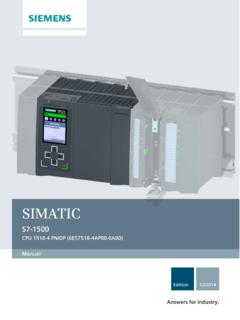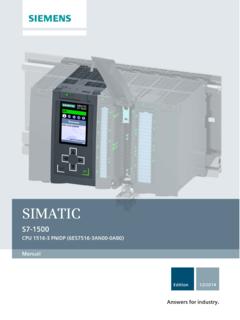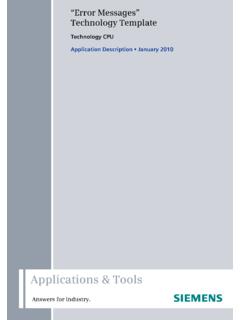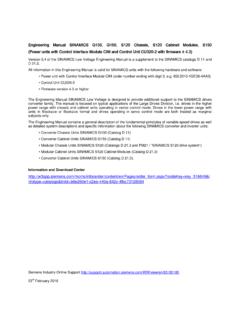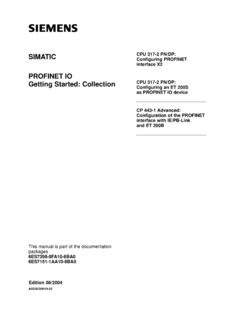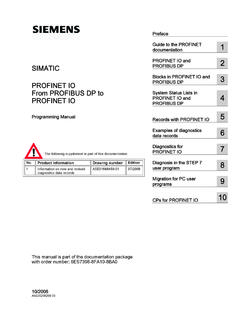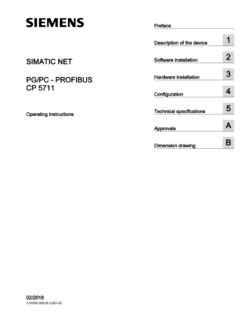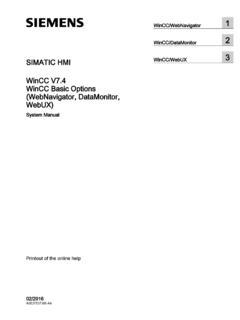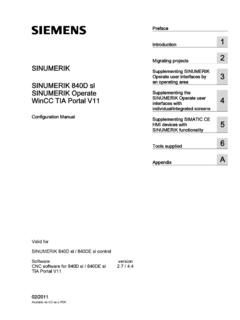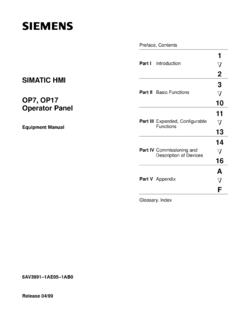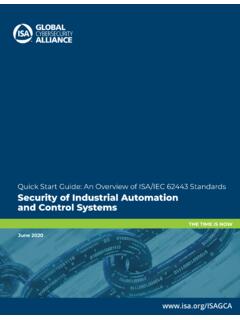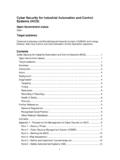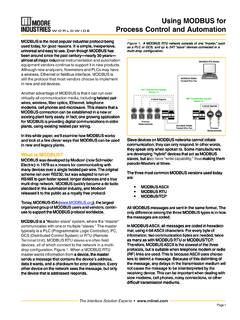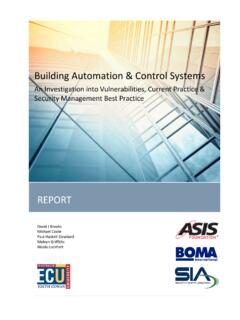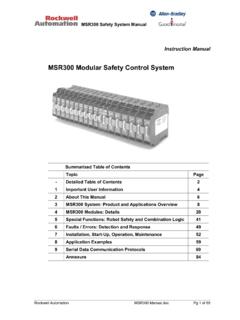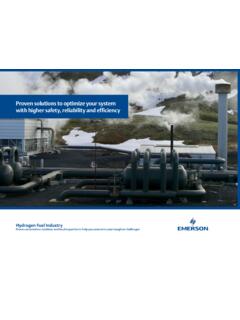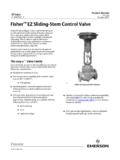Transcription of PID control with PID Compact - Siemens
1 PID control with PID_Compact SIMATIC S7-1200 / S7-1500 + TIA Portal Siemens Industry Online Support Legal information PID control with PID_Compact Entry-ID: 100746401, , 04/2019 2 Siemens AG 2019 All rights reserved Legal information Use of application examples Application examples illustrate the solution of automation tasks through an interaction of several components in the form of text, graphics and/or software modules. The application examples are a free service by Siemens AG and/or a subsidiary of Siemens AG ( Siemens ). They are non-binding and make no claim to completeness or functionality regarding configuration and equipment. The application examples merely offer help with typical tasks; they do not constitute customer-specific solutions. You yourself are responsible for the proper and safe operation of the products in accordance with applicable regulations and must also check the function of the respective application example and customize it for your system.
2 Siemens grants you the non-exclusive, non-sublicensable and non-transferable right to have the application examples used by technically trained personnel. Any change to the application examples is your responsibility. Sharing the application examples with third parties or copying the application examples or excerpts thereof is permitted only in combination with your own products. The application examples are not required to undergo the customary tests and quality inspections of a chargeable product; they may have functional and performance defects as well as errors. It is your responsibility to use them in such a manner that any malfunctions that may occur do not result in property damage or injury to persons. Disclaimer of liability Siemens shall not assume any liability, for any legal reason whatsoever, including, without limitation, liability for the usability, availability, completeness and freedom from defects of the application examples as well as for related information, configuration and performance data and any damage caused thereby.
3 This shall not apply in cases of mandatory liability, for example under the German Product Liability Act, or in cases of intent, gross negligence, or culpable loss of life, bodily injury or damage to health, non-compliance with a guarantee, fraudulent non-disclosure of a defect, or culpable breach of material contractual obligations. Claims for damages arising from a breach of material contractual obligations shall however be limited to the foreseeable damage typical of the type of agreement, unless liability arises from intent or gross negligence or is based on loss of life, bodily injury or damage to health. The foregoing provisions do not imply any change in the burden of proof to your detriment. You shall indemnify Siemens against existing or future claims of third parties in this connection except where Siemens is mandatorily liable. By using the application examples you acknowledge that Siemens cannot be held liable for any damage beyond the liability provisions described.
4 Other information Siemens reserves the right to make changes to the application examples at any time without notice. In case of discrepancies between the suggestions in the application examples and other Siemens publications such as catalogs, the content of the other documentation shall have precedence. The Siemens terms of use ( ) shall also apply. Security information Siemens provides products and solutions with industrial security functions that support the secure operation of plants, systems, machines and networks. In order to protect plants, systems, machines and networks against cyber threats, it is necessary to implement and continuously maintain a holistic, state-of-the-art industrial security concept. Siemens products and solutions constitute one element of such a concept. Customers are responsible for preventing unauthorized access to their plants, systems, machines and networks.
5 Such systems, machines and components should only be connected to an enterprise network or the Internet if and to the extent such a connection is necessary and only when appropriate security measures ( firewalls and/or network segmentation) are in place. For additional information on industrial security measures that may be implemented, please visit Siemens products and solutions undergo continuous development to make them more secure. Siemens strongly recommends that product updates are applied as soon as they are available and that the latest product versions are used. Use of product versions that are no longer supported, and failure to apply the latest updates may increase customer s exposure to cyber threats. To stay informed about product updates, subscribe to the Siemens Industrial Security RSS Feed at: Table of contents PID control with PID_Compact Entry-ID: 100746401, , 04/2019 3 Siemens AG 2019 All rights reserved Table of contents Legal information.
6 2 1 4 Overview .. 4 2 5 Overview .. 5 Description of the core functionality .. 6 Hardware and software components .. 7 Validity .. 7 Components used .. 8 3 Principle of operation .. 9 Complete overview .. 9 OB "Main" .. 10 FB "Hmi" .. 10 OB "CyclicInterrupt" .. 11 FB "PID_Compact" .. 12 FB "Simulation".. 14 4 Installation and 17 Hardware adaptation .. 17 Configuration .. 20 Transferring I/O addresses .. 20 Configure PID 21 CPU simulation with PLCSIM .. 24 Commissioning the Compact controller .. 25 HMI device .. 27 Load HMI project part into KTP900 Basic .. 27 HMI simulation .. 27 5 Operation of the application 28 Overview .. 28 Overview (start screen) .. 28 Trend view .. 30 Tuning .. 32 Monitoring .. 35 Alarm view .. 36 Configuration .. 37 Simulation .. 40 Settings .. 41 6 Appendix .. 42 Service and support.
7 42 Links and Literature .. 43 Change documentation .. 43 1 Task Overview PID control with PID_Compact Entry-ID: 100746401, , 04/2019 4 Siemens AG 2019 All rights reserved 1 Task Overview Introduction For the targeted influencing of certain quantities in a technical system, these quantities must be controlled. Controllers are also used in a wide variety of applications in automation technology, for instance speed control . For the SIMATIC S7-1200/S7-1500, the technology object "PID_Compact" is provided for proportional actuators. Description of the automation task The automation task consists of setting up a control loop to influence physical variables in a technical process. The control loop should consist of the following elements: "PID_Compact" as controller Simulated technical processes as a controlled system Figure 1-1 ControlledsystemHMIS etpointProcess valuePID_CompactControldeviationPT1 Controller The following points are described in the application example Configuration and parameter assignment of the software controller ("PID_Compact") Tuning options for "PID_Compact" Operation and monitoring of the control process via HMI 2 Solution Overview PID control with PID_Compact Entry-ID: 100746401, , 04/2019 5 Siemens AG 2019 All rights reserved 2 Solution Overview Diagram The following diagram shows the most important components of the solution: Figure 2-1 PC-Station:HMI-Visualisierungder SzenarienIndustrial EthernetField PGKTP900 Basic PN2nd GenerationTIA portalS7-1x00 CPU.
8 ProgrammwithPID_Compactand simulationHMI:processoperationand visualizationFieldPG:configurationand commissioningCPU 1211 CCPU 1511C-1 PNThe "PID_Compact" technology object reads the measured process value and compares it with the setpoint (in this example, the setpoint is set via HMI). From the resulting control deviation, the controller calculates an output value in order to adjust the setpoint deviation or the disturbance variable if necessary. The output value of the PID controller consists of three components: P component The P component of the output value is proportional to the control deviation. I component The I component of the output value is the integral component. This increases as long as there is a control deviation. D component The D component is the differential component and increases as the rate of change of the control deviation increases.
9 The "PID_Compact" technology object has the "tuning" commissioning functionality with which the P, I and D parameters can be calculated automatically depending on the controlled system. However, you can also specify the control parameters manually. The automatic tuning is divided into tuning types: 1. Pretuning and 2. Fine tuning Both types of tuning are described below. 2 Solution Description of the core functionality PID control with PID_Compact Entry-ID: 100746401, , 04/2019 6 Siemens AG 2019 All rights reserved Description of the core functionality The core functionality of the application example lies in the operation of the technology object "PID_Compact" via the HMI. Overview and description of the interface Figure 2-2 Trend viewTuningMonitoringAlarm viewConf igurationSimulation The operation of the application example consists of the following 6 screens: Trend view Tuning Monitoring Alarm messages Configuration Simulation The operation of the interfaces is described in more detail in the chapter Operation of the application example.
10 Advantages of this solution The application example allows you to use all configuration options and commissioning features via an operator panel or HMI simulation. This application example offers you the following advantages: Switchover between automatic and manual mode Trend view of setpoint, process and manipulated value via HMI Switchover between real controlled system and simulation Disturbance compensation in simulated operation Specification of the behavior in the event of an error and its simulation Manual controller parameter setting and automatic tuning Online monitoring of the "PID_Compact" controller module Configuration change at runtime 2 Solution Hardware and software components PID control with PID_Compact Entry-ID: 100746401, , 04/2019 7 Siemens AG 2019 All rights reserved Delimitation This application example provides an overview of the "PID_Compact" technology object for commissioning with the SIMATIC S7-1200/S7-1500.
